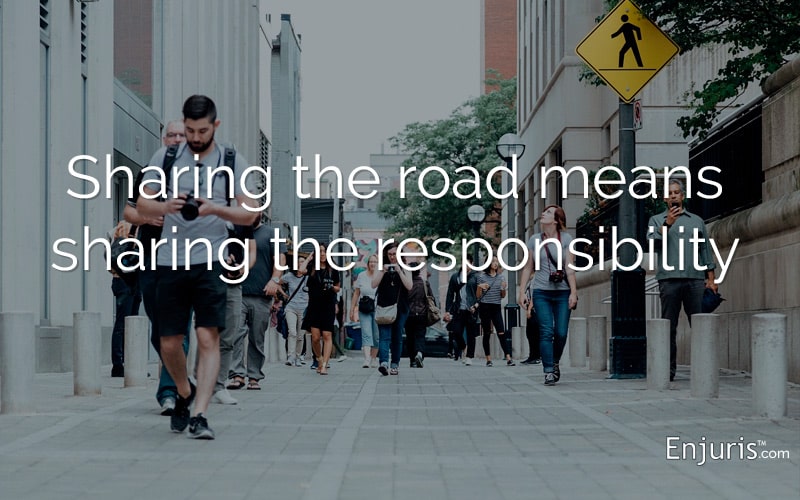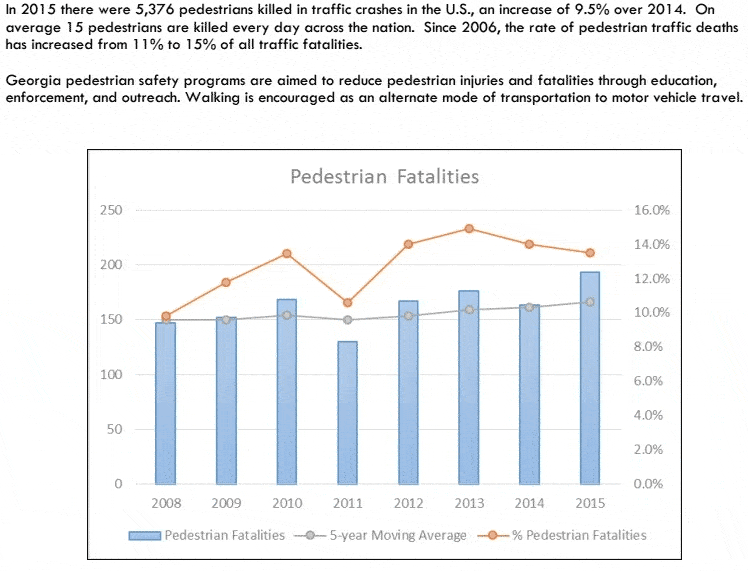Understanding fault and potential recovery for these deadly accidents
Whether a person is enjoying city life in Atlanta or strolling through the vacation spots of Savannah or Tybee Island, walking seems like the perfect mode of transportation for Georgia residents and vacationers. Unfortunately, this relaxing activity isn’t without significant hazards. In 2017 alone, 260 pedestrians were struck by a car and killed in Georgia. Fulton and Dekalb counties had the most pedestrian deaths.
The Georgia Governor’s Office of Highway Safety expressed concern over the number of pedestrian fatalities, stating: “The safety and accessibility of pedestrian walkways are critical issues throughout the state and in urban areas.”
With the increase in pedestrian accidents in Georgia, more personal injury and wrongful death lawsuits can and should be filed. Being hit by a car or other vehicle likely causes catastrophic injuries if the victim survives, and compensation should be awarded to either the accident survivor or their family.
Causes of pedestrian accidents in Georgia
Accidents can be caused by a variety of factors. The Insurance Institute for Highway Safety (IIHS) identifies the following causes and conditions that lead to pedestrian accidents and death:
- Pedestrian crashes are most likely to involve SUVs and high horsepower vehicles
- Most accidents happen at night when visibility is low
- Accidents are most common in urban and suburban areas
- Accidents tend to take place outside of intersections
- Accidents are often on busy, arterial roads
- “Road design, vehicle design and lighting and speed limit enforcement” are all contributing factors, according to IIHS
Though the above are the factors identified by IIHS, other causes of pedestrian accidents with cars or other vehicles include:
- Drowsy driving
- Driving under the influence of drugs or alcohol
- Distracted driving
- Speeding
- Failing to follow street signs such as stop or yield
- Failing to come to a complete stop at a crosswalk or intersection
- Backing up without checking to see if a person was behind the vehicle
- Not slowing down at a crosswalk
In all of the causes listed above, a driver would be liable for the injuries or death to the pedestrian they struck.
Pedestrian fault in accidents
Motor vehicle drivers are often to blame in pedestrian accidents. All drivers have a legal duty to drive in manner that is safe to all other drivers, bicyclists and pedestrians. Whenever that duty is breached or ignored, the plaintiff may file a negligence claim.
Pedestrians, however, also have a responsibility to walk or jog in a responsible manner. Mistakes or careless behavior could cause an accident. Pedestrians may be found at fault for pedestrian accidents when they:
- Text while walking or jogging
- Talk on the phone while walking or jogging
- Walk while under the influence of drugs or alcohol
- Walk or jog with headphones at too high a volume
- Ignore or disobey street signs or other traffic rules
- Jaywalk (cross a street outside of a designated crosswalk)
- Fail to monitor on-coming traffic while exiting or entering their vehicle
- Crossing the street outside of an intersection.
- Suddenly run into the road
Additionally, caregivers may be held accountable for not assisting small children, the physically disabled and the elderly while crossing the street.
If a pedestrian is found to be partly to blame for their accident, the judge or jury panel will assign a percentage of fault to the pedestrian. That percentage must be less than 50% in order for the plaintiff to recover damages.
Furthermore, a pedestrian’s percentage of fault also limits their total compensation. For example, if you were struck while walking and texting, you may be considered to be 40% at fault. If your total damages were $100,000, your recovery would be cut by 40% or $40,000. Thus, you would only recover $60,000.
Though not required by law to do so, pedestrians are encouraged to wear clothing that enhances visibility if walking or jogging at night. Pedestrians are also advised to try and make eye contact with drivers in order to detect if the driver is paying attention.
Georgia laws regarding pedestrian accidents
It’s important to note that Georgia drivers must follow the law in order to prevent additional penalties in pedestrian accidents. Georgia statute §40-6-93 states:
“Every driver of a vehicle shall exercise due care to avoid colliding with any pedestrian upon any roadway, shall give warning by sounding his horn when necessary, and shall exercise proper precautions upon observing any child or any obviously confused, incapacitated, or intoxicated person."
Accordingly, drivers must do everything possible to warn a pedestrian of a potential accident, and use particular care when driving near the elderly and children.
Tweet this
Though drivers are responsible for following the law, Georgia law also addresses pedestrian responsibilities. Georgia statute §40-6-92 explains several rules that pedestrians must follow. In short:
1. Pedestrians must yield to traffic unless the person has already entered the road.
2. Unless directed otherwise, pedestrians may not cross in a diagonal direction.
3. Pedestrians must use crosswalks when they are in between traffic signals; otherwise, this is considered jaywalking.
If a pedestrian or driver violates the law and is partially responsible for an accident, this is called “negligence per se.” In these cases, both the driver and/or pedestrian would be assigned a higher level of fault and the damage calculations would be adjusted accordingly.
Options for financial recovery for pedestrians
Pedestrians hit by a car typically suffer from arm, leg and head injuries. Accordingly, these injuries may be catastrophic or at least require extensive medical care.
If the pedestrian is 100% at fault, such as crossing the street while high on drugs, they may be protected by the personal injury protection coverage of their car insurance policy. This is optional coverage, however, and may not be enough to cover all medical expenses.
In many cases, the driver’s insurance plan will offer some form of settlement that the victim must either accept or decline. If the compensation seems too small, or if the driver lacks insurance, you may want to consult a Georgia personal injury attorney to determine if you should pursue legal action.
More resources
- "EVERYONE IS A PEDESTRIAN" online resource
- "SAFETY IN NUMBERS" newsletter on pedestrian safety
- GA DMV guide for what to do after an accident
- Pedestrian safety tips from the Georgia Governor's Office of Highway Safety
- The Georgia DOT’s Bicycle & Pedestrian Program
See our guide Choosing a personal injury attorney.



